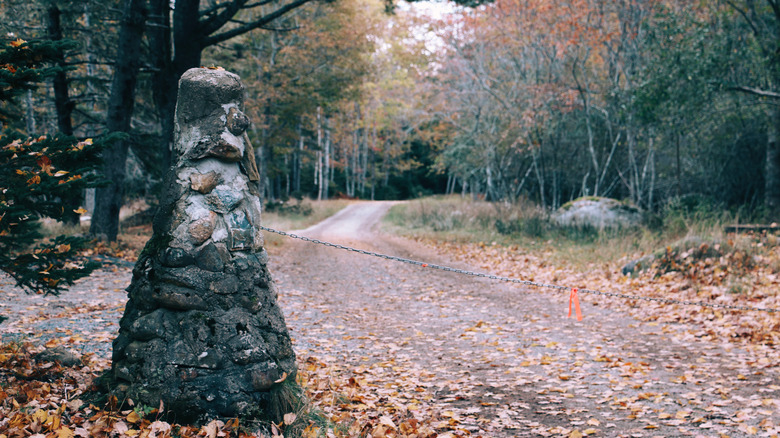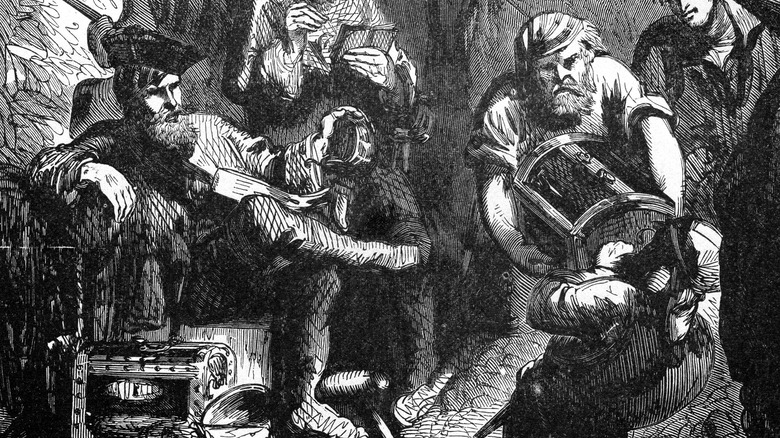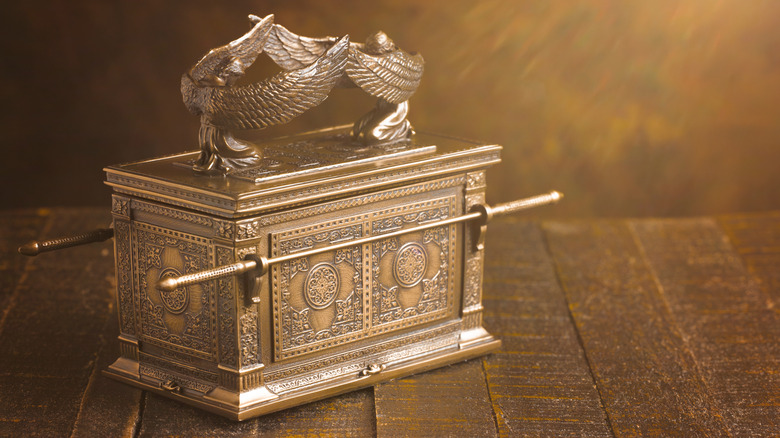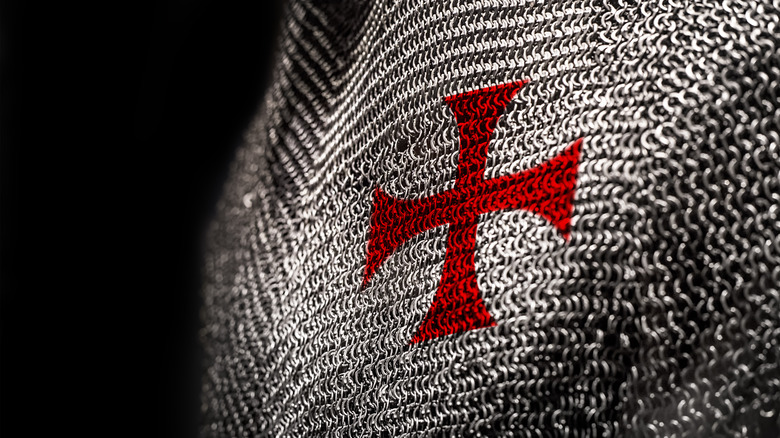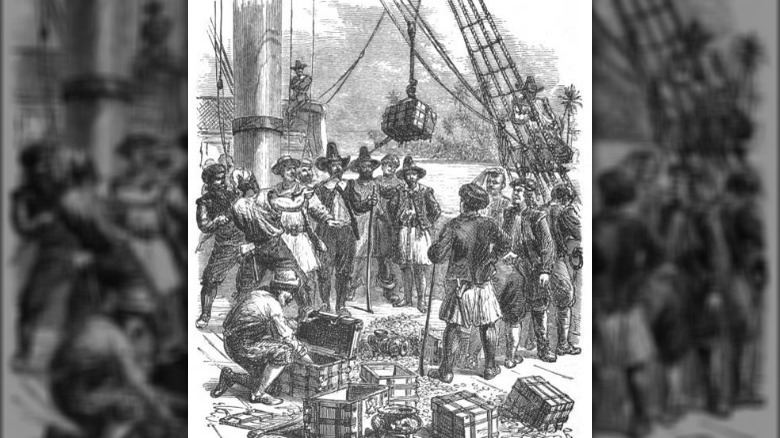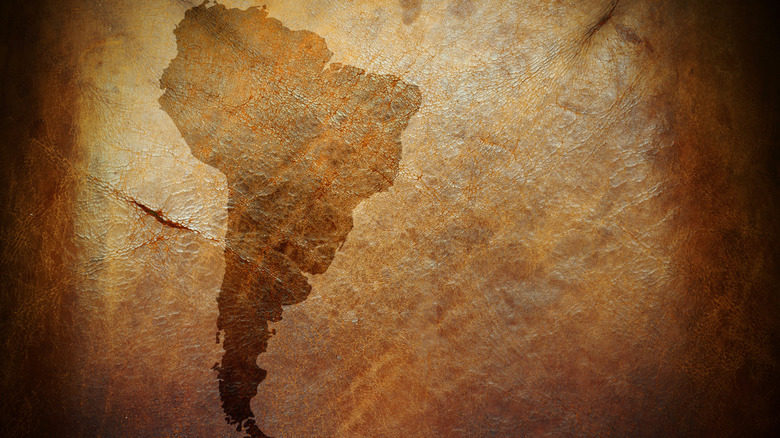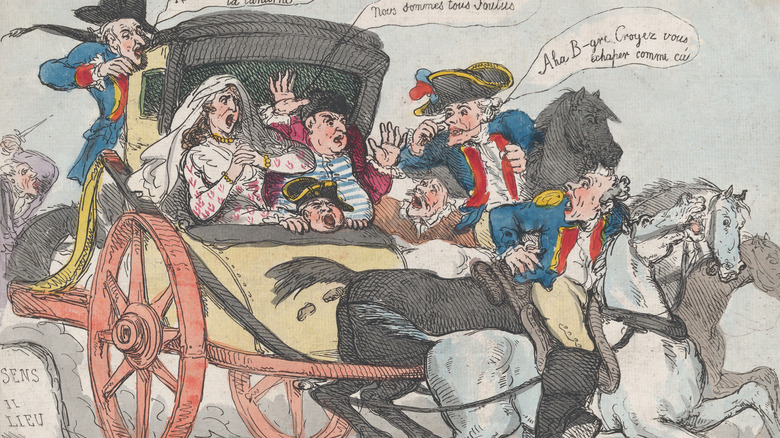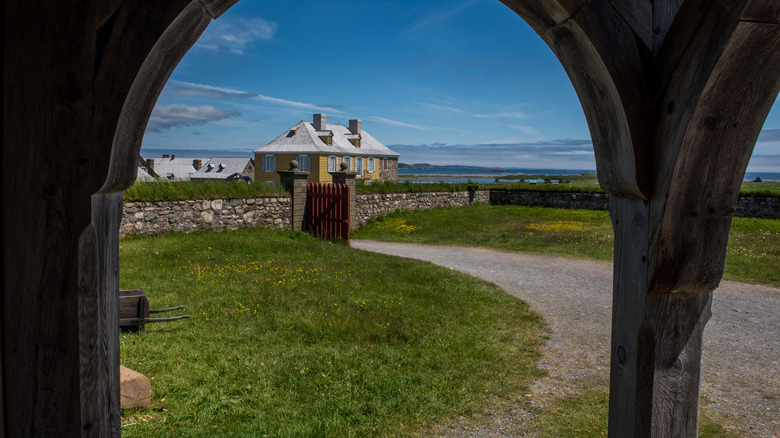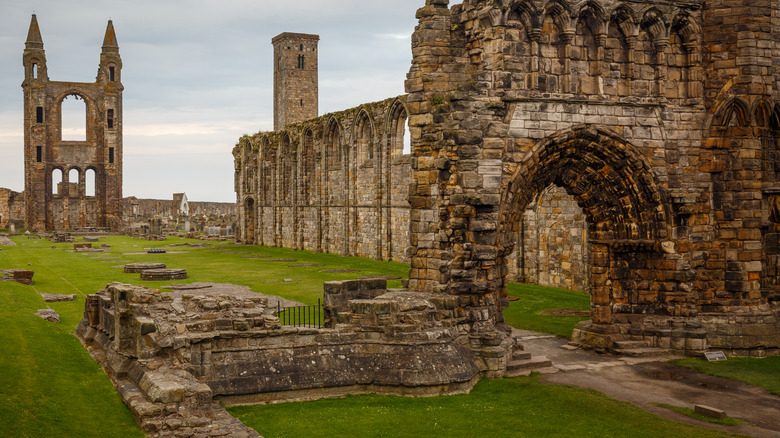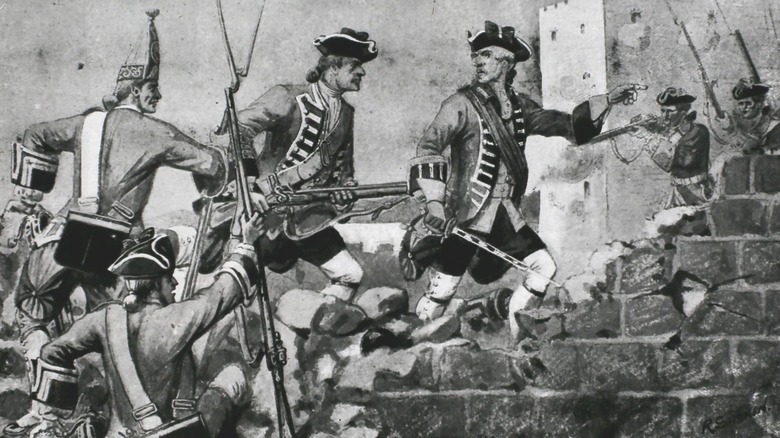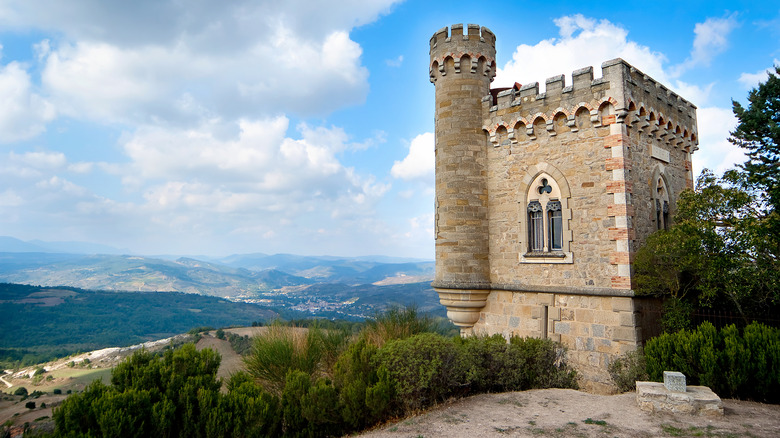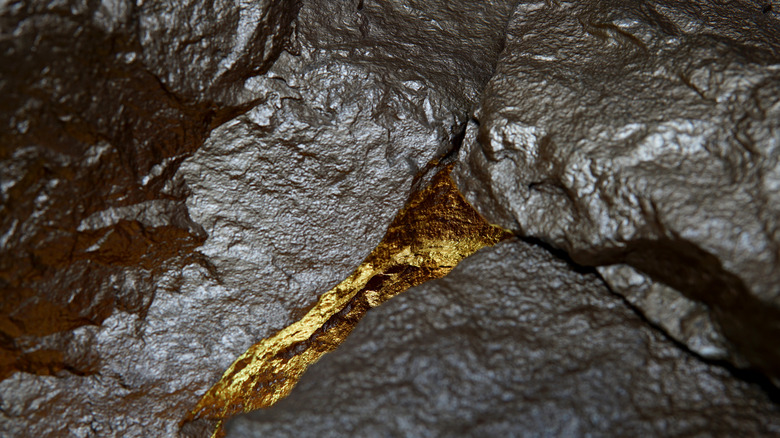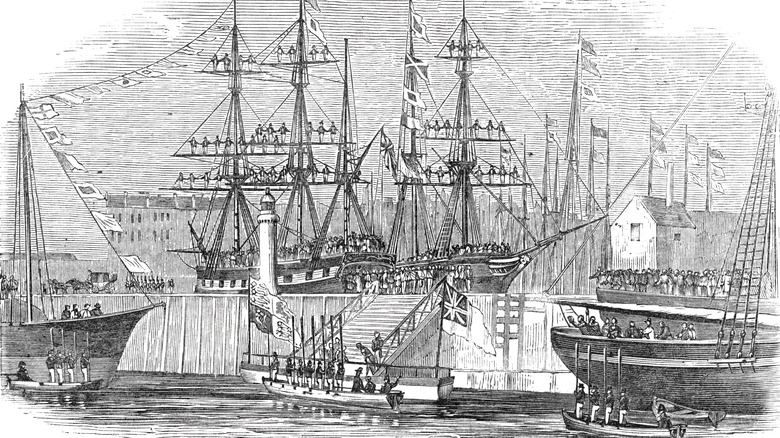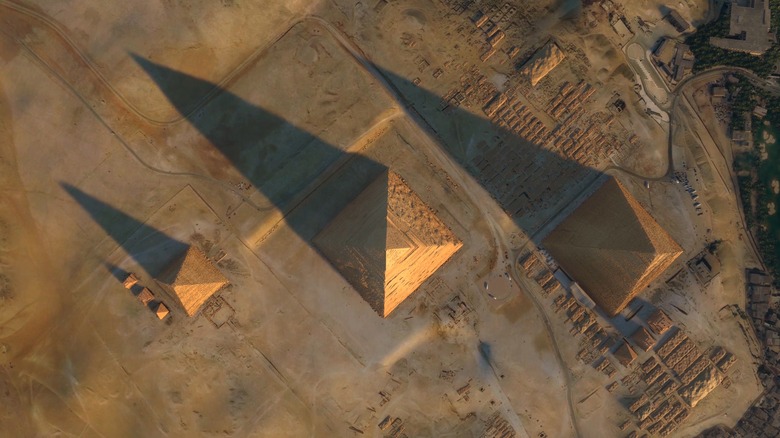Everything Rumored To Be Buried On Oak Island
It's easy for cynics to say that there's absolutely nothing to Oak Island, except for a lot of hype around mysterious buried treasure and a curse that supposedly says that seven people need to die on the island before anyone finds that treasure. Sure, it sounds unlikely, but here's the thing: It has claimed lives, and six people have already died there.
First, here's a refresher, with help from Popular Mechanics. Most of the mystery revolves around the so-called Oak Island Money Pit, which dates back to 1795. That's when a Nova Scotia teen claimed to have seen some suspicious activity in the area, and he and some friends first started digging out what would become the Money Pit. Then, the Onslow Company took up the torch in the early 1800s. (Supposedly, as actual records are sketchy.) They found some things that even cynics have to admit are pretty weird, like coconuts (which definitely aren't native to Canada), and a stone etched with some mysterious runes. It wasn't until the 1860s that a Dalhousie University professor translated them to say "Forty Feet Below Two Million Pounds Are Buried."
Others have translated the runes in very different ways, but people never really looked back after the promise of treasure. But ... what treasure are we talking about here? It turns out that there's a ton of theories with varying degrees of believability, so let's take a look at them all — and, how likely they might be.
Captain Kidd's treasure
All good stories have to start somewhere, and according to Maclean's, the very first treasure mentioned in the same breath as Oak Island was the long-lost treasure of Captain Kidd.
The story goes like this, says the CBC: Way back in 1795, a man claiming to have been one of the crewmen on board the notorious pirate's ship told would-be treasure seekers that the booty had been buried on Oak Island. When people started digging and found the remains of coconuts, it seemed like it was even more straightforward. Clearly, there was pirate treasure here! (Never mind that Popular Mechanics says that coconut fibers were commonly used as packing material at the time — that's the sort of negativity optimistic treasure hunters clearly don't need in their lives.)
This theory has kind of fallen by the wayside for a few reasons. For starters, mainstream historians have shown that Captain Kidd was never up around Nova Scotia, and here's the really fun thing: Captain Kidd's treasure has actually been discovered. In 2015, Madagascar's government released photos (via The Guardian) of an underwater expedition that had recovered silver from a ship thought to be Kidd's ship, the Adventure Galley. Given that the Smithsonian says Kidd ran his no longer seaworthy ship aground in Madagascar in 1698, that tracks. Sorry, Oak Island.
The Ark of the Covenant
When it comes to history's most fascinating missing objects, the Ark of the Covenant is on everyone's list... even though everyone also knows it's really stashed in a warehouse being guarded by "top men." National Geographic says that the Ark is not only said to contain the Ten Commandments, but it's also associated with a few miracles, too.
There are a few different theories about what happened to it, and some are more plausible than others. In the "others" category is the idea that it's buried on Oak Island, and when Gizmodo did a deep dive into the theory, they found that getting the Ark to Nova Scotia took some mental gymnastics.
The theory, says Ancient Origins, starts with the Knight Templar. Documents long hidden by the Vatican claim that the Templars returned from the Holy Land with some relics, with one of those relics often said to be the Ark of the Covenant. There's a ton of theories about what happened to it next, and here's where things get pretty hopeful. Oak Island has an association with the Templars entirely thanks to a set of boulders that sort of makes the shape of a cross. The 6 stones — which weigh about 10 tons each — are scattered across the island, and make the shape of a cross if they're connected by lines. Does X mark the spot where the Ark of the Covenant has been sitting all these years?
The treasure of the Freemasons/Knights Templar
In addition to the specific treasure of the Ark of the Covenant, there's also a theory that the Freemasons and the Knights Templar buried all kinds of other treasures on the island. Oak Island Treasure draws all kinds of parallels between the Money Pit and the Masons, going as far as saying that the tools that treasure hunters use — like axes and spades — are important items in Masonic symbolism, and the three men who originally started digging could be described as the Three Worthy Sojourners. What's that have to do with what's buried there? Who knows!
Other artifacts have also been said to identify Oak Island as a Masonic treasure vault, including a boulder with a "G" carved into it, and a stone that someone carved into a heart at some point.
The Templars were slaughtered en masse in 1307, and it's long been said that their insane wealth — which got them the jealous attention of the Pope and the Vatican in the first place — was loaded onto Templar ships and sent off... somewhere. Scotland is one of the most popularly cited destinations, and the Oak Island theory says that after ships went to Scotland and fell under the guardianship of the St. Clair (or Sinclair) family, they were then taken to Nova Scotia. There, it was buried in the Money Pit and marked with the not-at-all common symbol of a cross.
A Spanish galleon
When Dan Blankenship spoke to the National Post in 2010, he'd already been searching for treasure on Oak Island for 40 years. He hadn't found much, but he did explain what he hoped to find: "It has been my hope, over the years, that some of the Spanish captains took a detour on their way back to Spain. I am hoping that they wanted to start their own country and they built up a big treasury, because there are certain years when the fleets sailed [back to Spain] and had very little goodies on them."
The Wall Street Journal says that there are other theories that suggest a Spanish galleon may have gotten caught in a storm and ultimately left a cargo hold's worth of treasure there. Is there anything to it?
An article published in The Dalhousie Review says "maybe," and points to the rune-carved stone once recovered from the Money Pit (which has since gone missing). They say there's a possibility it was mistranslated, and some of the symbols weren't referring to an English alphabet, but a Spanish or Italian one. They also suggest that using a Spanish cipher called the Porta Cipher Disk translates the stone in a way that hints at how to disarm the flood traps of the Money Pit, and still further suggests that Spain is the only nation that would have had need of such a treasure vault.
William Phips' treasure
William Phips's story is pretty crazy to begin with: For starters, The Epoch Times says it was the fortune of this New England native that started the Bank of England. Weird? Absolutely. But what does it have to do with Oak Island? According to the New Boston Historical Society, Phips was a well-to-do sort who, in the late 17th century, became obsessed with the treasure that had been laying at the bottom of the oceans. In 1685, he got a lead on the final resting place of the Nuestra Senora de la Concepcion, a Spanish ship that had been hit by a hurricane then run aground on a coral reef near Cuba.
Phips — convinced that a super old guy he'd met at a tavern really was one of the survivors of the wreck — financed an expedition to go looking for it. Then, he actually found it, salvaged at least 30 tons of silver, and took it back to England. That earned him a knighthood and a massive "thank you," but here's the thing: Not everyone thinks he took all the treasure he salvaged back to Blighty.
Oak Island Mystery says that one of the long-running theories is that Phips — who spent a good amount of time around Quebec and Port Royal — had built a treasure vault on Oak Island to hide the treasure that he didn't want to share. He died just eight years after salvaging the Concepcion, and the treasure was — theoretically — never recovered.
Blackbeard's treasure
Listen to all the theories, and it's clear that Oak Island is reported to be some sort of pirate's dream come true as far as leaving buried treasure behind. Maybe there's a What's App group for that? Whatever messaging system they're using, rumor has it that Blackbeard got on board, too.
And weirdly, that's kind of what Oak Island Treasure suggests. Even as they admit that the only connection between Blackbeard and Oak Island's Money Pit is that he was fond of saying that he buried his treasure "where none but Satan and myself can find it," they also describe the potential for Oak Island to be "a communal bank for pirates." Each pirate, they suggest, had a tunnel dug out from the main Money Pit that's been so determined not to give up whatever secrets it might be holding.
How likely is this one? Not super likely. When Mental Floss assembled a list of all the possible places Blackbeard may have actually buried his treasure, there were plenty of places in North Carolina and the Caribbean that have been the subject of speculation... but Oak Island didn't get a serious second glance.
Shakespearean manuscripts
Oak Island Mystery says there are a number of bizarre theories about Oak Island, and among the weirdest is the idea that deep beneath the island is a secret chamber, and in that chamber are scores of original manuscripts from William Shakespeare and some of his contemporary writers and playwrights. Why were they put there? Who knows!
The theory hinges on the idea that Shakespeare wasn't actually the author of Shakespeare's work, and instead, famous plays like "Romeo and Juliet" and "Hamlet" were the work of Sir Francis Bacon. It's not an unheard-of theory, and Europeana says Bacon — who revolutionized the way scientists investigate the world around them — has long been thought to have been the man who actually wielded the pen, while William Shakespeare just sort of took all the attention.
The theory goes that Bacon — who was also involved with the Knights Templar, who are often said to have something to do with the island — secreted the original manuscripts away for safekeeping, and did it with the help of his secretary, Thomas Bushnell. In addition to having experience working with flooded mines, Bushnell also mysteriously disappeared between 1647 and 1652. Was he building a secret manuscript repository at Oak Island? Not according to the Shakespeare Birthplace Trust, who thoroughly debunks the idea that it was Bacon who wrote the Bard's plays. We have some of Bacon's attempts at writing, they say, and it's less Shakespeare and more sort of ... Dan Brown.
Incan/Aztec/Mayan treasure
There are a few different ways that believers think ancient Incan, Aztec, or Mayan treasure may have made it to Oak Island, and the most plausible is also the most straightforward. Oak Island Mystery suggests that Spanish conquistadors were forced off-course near Nova Scotia, landed on Oak Island to seek shelter from storms, or landed there in order to stash some valuables for themselves. Even the biggest Oak Island skeptic has to admit that it makes sense some enterprising conquistadors would want to keep some of their booty, instead of handing it all over when they got back to Spain.
There's another version that makes less sense, and that's the one that stars a double-crossing Francisco Pizarro. Pizarro, says National Geographic, captured the Inca king Atahualpa. He demanded a massive ransom in exchange for the man's life, but before the final part of the ransom was delivered, he perhaps predictably killed Atahualpa. The treasure had already been collected and it was very, very real, but it was never found.
Explorers have been looking for the lost Inca gold since at least the mid-19th century, and even though Barth Blake reportedly found it in South America in 1886 (before mysteriously disappearing himself), bizarrely, that's where some think Oak Island comes in. There's a theory that says the king's general absconded with the treasure and headed all the way up to Oak Island — more than 3,500 miles away — to bury it. Why? Because ... reasons.
Marie Antoinette's jewels
Oak Island has captured the imaginations of countless people over the years, including U.S. President Franklin Delano Roosevelt. According to documents from the Franklin D. Roosevelt Presidential Library & Museum (via Mysteries of Canada), FDR's maternal grandfather had been invested in Oak Island treasure hunting — and he was convinced that they were going to find Marie Antoinette's jewels.
Things really went sideways for the French monarchy in the 1790s, and Marie Antoinette — along with husband Louis XVI — saw the writing on the wall. They tried to flee during the so-called Carnation Affair, says HistoryExtra, but we all know that her life ended not in exile, but on the guillotine.
Her jewelry began a supposed trip to Oak Island in 1791, when— the story goes — Marie gave gems (and the Crown Jewels of France) to her Lady-in-Waiting even as she and Louis fled for the Austrian Netherlands. (They were recognized and escorted back to Paris.) What was no longer with them were the gems and jewels in question, which were said to have been safely in the possession of the Lady-in-Waiting, who headed to a Louisbourg fort. When the monarchy fell, she reportedly buried the jewels on Oak Island. The biggest problem with this? The Crown Jewels were stolen in 1792, and have since all been recovered.
A Louisbourg pay-ship
Nova Scotia's official site describes the Fortress of Louisbourg as it exists today as "the largest historical reconstruction in North America." The 18th-century fort was built over the course of 20 years — beginning in 1720 — and it goes without saying that a project like that isn't cheap.
And that, says Oak Island Mystery, is where the treasure comes in. There's a theory that suggests a pay-ship carrying a cargo hold full of cash destined for paying the men working on the fort could have been either caught in a storm, wrecked on Oak Island, or gotten the attention of pirates, who ended up burying the treasure on the island. It's actually not as far-fetched a theory as it might seem: a 1966 article in Maclean's says that a French pay-ship called the Le Chameau was exactly what was shipwrecked off a Cape Breton reef in 1725.
The ship sat there for a while before salvage operations were able to take place, and is it possible that there's another ship just like it, that left a fortune in cargo on Oak Island?
Treasure from Scotland's St. Andrews's Cathedral
The Courier says that it's difficult to stress the importance of St. Andrew's Cathedral. In its heyday — it was dedicated in 1318 — it was the center of Catholicism in Scotland. It was the centerpiece of a major pilgrimage route, and it was full of relics, artwork, and artifacts ... until it wasn't.
The cathedral didn't do well through the Scottish Reformation, and it was looted in the mid-16th century. By 1561, there wasn't too much left. Abandoned and ruined, it was just left to history to try to figure out what had happened to the treasures it had once contained. Some suggest that the monks saw the writing on the wall, and hid their relics and artifacts from the angry mobs they knew were coming. Theories range from the presence of a series of undiscovered tunnels beneath the ruins of the cathedral to — of course — Oak Island.
Oak Island Mystery says that the theory is that the treasures ended up on a boat to Nova Scotia, and while they say it's not impossible, they also say that there's really no more meat to the theory. It's never been linked to a particular group, ship, or time, and it's never been satisfactorily explained just why the protectors of the St. Andrew's treasure opted to keep it safe by burying it on an island across the ocean.
Treasures looted from Havana
The Navy Records Society calls the British campaign to first lay siege to and then capture Havana from the Spanish the "forgotten campaign of the Seven Years' War." That's weird, because it was a huge deal — Havana was, at the time, a jumping-off point for ships heading back to Spain with treasures looted from the New World, and here's where Oak Island comes in.
When Havana fell to the British, they found a ton of treasure in the city. But, according to "The Mystery of the Oak Island Treasure: Two Hundred Years of Hope and Despair," the British reported looting about £737,000 worth of goods. It sounds like a lot, sure, but at the time, the Spanish were supposedly sitting on millions more.
The theory says that rather than returning the lion's share of the treasure to England, some of it was diverted to Oak Island. At the time, it was a newly founded outpost, and it's theorized that British soldiers stashed much of the loot there. Legends from the young Oak Island settlement say that men in distinctive red coats were seen around various surveyed-but-unsettled lots, giving rise to the theory that some of Spain's looted treasures made it to the island via Havana.
The treasure of Rennes le Chateau
The little town of Rennes le Chateau is proof that conspiracy theories are nothing new. It started, says Atlas Obscura, in the 1950s, when villagers started a rumor that the long-lost treasure of Louis VIII's wife had been discovered. That was pretty much the extent of the claims, so imagination took over, and then, a man named Pierre Plantard stepped in and did the conspiracy theorist equivalent of saying, "Here, hold my beer."
Plantard went on to invent the Priory of Sion, claiming it was a centuries-old society all about prophecies, treasure, new world orders, etc., etc. (And yes, this is what was picked up in the "Da Vinci Code.")
Even though it was definitely fake, treasure hunters searched Rennes le Chateau in the poor town's entirely... just in case — and here's where the treasure comes in. Oak Island Treasure says that this particular theory says that treasure from the sacking of Jerusalem in the year 70 made it into the hands of the Visigoths, and at the end of the 19th century, ancient carvings were discovered in the church at Rennes le Chateau. The parish could suddenly afford to give the whole place an overhaul, and add in a deathbed confession and some gold bars, and you have the story that the treasure of Rennes le Chateau made it into the hands of the local Knights Templar, who then took it to Oak Island for safekeeping.
A Pyrite mine and a tomb
In 1997, researchers from The DeVere Foundation prepared a fascinating paper for the Nova Scotia Museum. In it, they argued that there was something buried on Oak Island: Edward DeVere, the 17th Earl of Oxford.
The theory, they said, started with Captain Martin Frobisher. Frobisher (says The Canadian Encyclopedia), was one of the 16th-century explorers who was determined to find the Northwest Passage. He was heavily financed by Edward DeVere, who was incidentally one of the candidates for being the author of Shakespeare's works (via the Shakespeare Oxford Fellowship).
Frobisher, the story goes, discovered what he believed to be gold on Oak Island. Oak Island Mystery says that what he was actually mining was pyrite — fool's gold — which was discovered during smelting operations on Oak Island. The mines were ultimately abandoned, but the second part of the theory suggests that in the 17th century, the mine was then converted into a tomb. The booby traps along the so-called Money Pit were designed to keep would-be grave robbers from getting into the mausoleum, which was then thought to be the final resting place of not only Edward DeVere, but proof that he was also the original author of Shakespeare's manuscripts. Confused yet? You bet!
A top secret, olde-timey industrial center
Not all of the theories about Oak Island involve treasure of the gold, silver, and jewels sort. According to historian Joy A. Steele and marine geologist Gordon Fader, there's a different kind of treasure on Oak Island: an archaeological one. They say (via Popular Mechanics) that documents dating back to the 1720s confirm a partnership between the British military and a series of privately-owned companies that oversaw the building of a massive industrial complex on Oak Island.
At the heart of the complex was a pine tar kiln, and it would have been massively important to their shipbuilding industry and their navy. The island would have been the perfect place to produce the tar and pitch that would be then used to treat ships, and what's been found in the so-called Money Pit — specifically, things like putty and charcoal — are what's expected to be found in a pine tar kiln site.
It was so important that Steele says it's the industry referred to as "The Secret" in many documents, and explained: "I am surprised historians never picked up on this ... [Oak Island] carried out what would have been a very lucrative commodities scheme."
An ancient Egyptian treasure
For the sake of completionism, let's take a look at this completely wild theory. Oak Island Treasure says that some of the imagery reportedly found on Oak Island has connections not just to the Freemasons, but also to ancient Egypt. So far, so good. The cipher stone that supposedly had these symbols on it is long gone, but that hasn't stopped some people from suggesting that what's actually on Oak Island are the Great Pyramids of Khufu.
"But wait," skeptics might say. "Aren't those in Egypt?" Clearly, those skeptics are unfamiliar with how conspiracy theories work.
Erik Orion puts forward a completely epic theory that says long-time Oak Island treasure hunter Dan Blankenship had actually discovered the pyramid long ago and built his house on the entrance. Then, the governments of the U.S., Canada, and Russia teamed up with the Vatican and the Freemasons, and the end result was that those in the know spent hundreds of years excavating all the gold from the ancient Egyptian pyramids. Of Oak Island. Orion claims that those who died on Oak Island had actually gotten too close to the truth, and were silenced to keep this massive secret quiet. It's certainly ... well, it's a theory!
